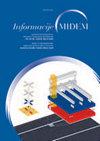精通静态RAM设计,使用sleep Keeper泄漏控制晶体管和pt解码器用于手持应用
IF 0.8
4区 工程技术
Q4 ENGINEERING, ELECTRICAL & ELECTRONIC
Informacije Midem-Journal of Microelectronics Electronic Components and Materials
Pub Date : 2019-02-01
DOI:10.33180/INFMIDEM2018.401
引用次数: 6
摘要
静态随机存取存储器(SRAM)由于其存储容量大、存取时间短等优点,已成为众多超大规模集成电路芯片的重要组成部分。低功耗足够的内存配置是SRAM设计中最具挑战性的问题之一。随着技术节点的缩小,漏电利用率已成为一个值得关注的问题。本文提出了一种适用于手持设备的新型供电技术,即休眠保持漏控晶体管技术(SK-LCT)。SRAM架构有两个主要组成部分,即SRAM单元和感测放大器。将SK-LCT技术应用于SRAM单元和感测放大器中,实现了一种新的低功耗高速SRAM架构设计。采用通晶体管译码器(pt译码器)的sram架构概要在功耗方面取得了较好的效果。利用TannerEDA工具在180nm工艺下进行了仿真,结果表明泄漏功率利用率和速度发生了显著变化。本文章由计算机程序翻译,如有差异,请以英文原文为准。
Proficient Static RAM design using Sleepy Keeper Leakage Control Transistor & PT-Decoder for handheld application
Due to their large storage capacity and small access time static random access memory (SRAM) has become a vital part in
numerous VLSI chips. Low power adequate memory configuration is a standout among the most challenging issues in SRAM design.
As the technology node scaling down, leakage power utilization has turned into a noteworthy issue. In this paper a novel power
gating technique, namely sleepy keeper leakage control transistor technique (SK-LCT) is proposed for a handheld gadget application.
The SRAM architecture has two primary components, specifically SRAM cell and sense amplifier. The proposed SK-LCT technique
is applied in both SRAM cell and sense amplifier for a new low power high speed SRAM architecture design. The outline of SRAM
architecture utilizing pass transistor decoder (PT-Decoder) gives better outcomes in term of power. Simulation is done using Tanner
EDA tool in 180nm technology and the results demonstrate a noteworthy change in leakage power utilization and speed.
求助全文
通过发布文献求助,成功后即可免费获取论文全文。
去求助
来源期刊
CiteScore
1.80
自引率
0.00%
发文量
10
审稿时长
>12 weeks
期刊介绍:
Informacije MIDEM publishes original research papers in the fields of microelectronics, electronic components and materials. Review papers are published upon invitation only. Scientific novelty and potential interest for a wider spectrum of readers is desired. Authors are encouraged to provide as much detail as possible for others to be able to replicate their results. Therefore, there is no page limit, provided that the text is concise and comprehensive, and any data that does not fit within a classical manuscript can be added as supplementary material.
Topics of interest include:
Microelectronics,
Semiconductor devices,
Nanotechnology,
Electronic circuits and devices,
Electronic sensors and actuators,
Microelectromechanical systems (MEMS),
Medical electronics,
Bioelectronics,
Power electronics,
Embedded system electronics,
System control electronics,
Signal processing,
Microwave and millimetre-wave techniques,
Wireless and optical communications,
Antenna technology,
Optoelectronics,
Photovoltaics,
Ceramic materials for electronic devices,
Thick and thin film materials for electronic devices.

 求助内容:
求助内容: 应助结果提醒方式:
应助结果提醒方式:


